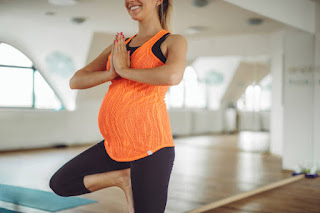Preparing for Birth: Strengthening and Opening for the Third Trimester

As you enter the third trimester of pregnancy, your body and mind are in the final stages of preparing for childbirth. In the yogic tradition, this is a time to nurture yourself from the inside out, gently stretching, strengthening, and opening to create ease in labor. Combining prenatal yoga with mindful breath, nutrition, and self-care can help expectant parents (and especially first-timers) feel more confident and calm about labor and birth. This article explores how to use yoga asanas (postures), breathwork, meditation, pelvic-floor exercises, and healthy lifestyle choices to prepare both body and mind for the birthing journey. We’ll also discuss important safety modifications for the growing belly, so you can practice in comfort. Throughout, the emphasis is on a holistic approach – one that integrates body, breath, and spirit in service of a gentle, empowered birth experience.
Physical Preparation with Yoga Asanas
The third trimester places new demands on your body: a heavier belly, shifting center of gravity, loosened ligaments, and increased pelvic pressure. Gentle, targeted yoga poses can ease these changes by opening the hips and pelvis and strengthening the core and legs, which are essential for labor. Emphasize shapes that create space in the pelvic outlet and support your growing weight. These include squatting postures, supported lunges, and hip-openers. For example, a deep squat (Malasana) with a prop or wall support can stretch the inner thighs and groin while gently engaging the pelvic floor. This posture mirrors the birthing squat and helps increase flexibility in the hip joints. Another helpful pose is Bound Angle (Baddha Konasana) – either seated or reclined (with bolsters under the knees) – which opens the hips and inner thighs, creating more room in the pelvis. Movements like Cat–Cow on hands and knees (with knees wider than hips) can also gently mobilize the spine and warm up pelvic joints, while allowing the belly to expand on the “cow” (arch) phase.
Supported Squat (Malasana) – Stand with feet wider than hips and toes slightly turned out. Sink down into a squat, using a wall or blocks under your sit bones if needed. Keep chest lifted and press knees gently outward with elbows. This pose strengthens the legs and opens the hips and groin, and the gentle downward pressure can help baby engage into the pelvis.
Bound Angle (Butterfly) – Reclined – Lie on your back or a supported bolster, with the soles of the feet together and knees falling open to the sides. A bolster or pillows under each knee makes this deeply relaxing. This posture stretches inner thighs and opens the pelvic outlet, and when done reclined it helps relax the belly and pelvic floor.
Side Lunge (Skandasana) or Lizard Lunge – From standing or half-kneeling, step one foot to the side and bend that knee while straightening the other leg to the side. This widens the pelvis and opens the hips. Keep the back straight or place hands on a block for support. Moving gently in and out of this lunge can be useful for groin mobility.
Bridge Pose (Setu Bandha Sarvangasana) – Lying on your back (knees bent, feet hip-width) lift the hips upward. The feet stay on the floor while the belly and thighs lift. Using a block under the sacrum can relieve pressure. Bridge strengthens the back, glutes, and legs, and by lifting the pelvic floor it also encourages relaxation of those muscles underneath. It is generally safe for late pregnancy if done in moderation and with alignment in mind.
Kneeling with Knees Together, Feet Apart – As Anna Carpio notes in a prenatal yoga guide, keeping the knees together and the feet apart on a block or cushion “practices internal rotation and alleviates tightness in the piriformis” (the deep hip muscle). This type of kneeling posture gently opens the hip sockets and relaxes the pelvic floor, helping to “open the outlet of the pelvis” – a key position for birthing.
These poses and variations strengthen the legs, hips, and core without overexertion. Strengthening the core muscles – including the back and abdominal muscles – helps carry the weight of the baby and supports the spine. However, in the third trimester it’s best to avoid strong twists, deep backbends, and lying fully on the back for long periods (the enlarged uterus can compress major blood vessels). Instead, focus on supported versions of familiar poses. Use yoga blocks, bolsters, straps or chairs liberally to take strain off sensitive areas. As your belly grows, widen your stance and lower to blocks or props so you never feel overstretched or unbalanced. The goal is to build functional strength in the legs, hips and back – the muscles you’ll use in labor – rather than pushing your flexibility. This means feeling a safe, active engagement (like pressing the feet into the floor) rather than intense strain.
Opening the Pelvis and Hips
By the third trimester, the hormone relaxin makes joints more mobile but also more prone to instability. To prepare the body for the demands of labor, focus on opening the hip joints and pelvis. Hip-openers encourage the baby to drop and align, and can relieve sciatica or low back pain. Gentle inner-thigh stretches and forward folds (with support) are often soothing. For example, Wide Child’s Pose (Upavistha Shishosana) or a Kneeling Lunge with Side Stretch can open the hip flexors and thighs. Even a modified downward-facing dog (knees bent, focusing on lengthening the spine rather than a deep hamstring stretch) is beneficial. Anna Carpio of Peloton recommends “internally-rotated hip openers” in the third trimester because they literally widen the outlet of the pelvis. Think of variations of pigeon pose, frog pose, or lifting one foot onto a chair in a low lunge – these keep the hip joint open. Any asymmetrical hip opener should be done mindfully; if one hip feels sharp or “off,” switch sides or use more props to balance the stretch.
Overall, these prenatal poses help you stay mobile and strong. Movement during late pregnancy isn’t just about flexibility; it’s about keeping your joints lubricated, improving circulation, and retraining your body to find ease with a changing shape (especially as swelling and weight increase). Repeat gentle flows or holds for a few breaths each, always listening to your body. When practiced regularly (even 15–20 minutes daily), prenatal yoga can reduce pregnancy-related discomforts like backache, hip pain, and swelling by improving posture and muscle tone. This means when labor arrives, your body is better conditioned and more resilient. In fact, systematic reviews find that pregnancy yoga programs can lower anxiety and stress, shorten labor, and improve the chances of a normal (vaginal) delivery, likely due to this combined effect of physical and mental readiness.
Breathwork (Pranayama) for Labor
In yoga, the breath is the bridge between body and mind. During pregnancy and birth, pranayama (breathing techniques) become powerful tools for calming the nervous system and coping with pain. Slow, deep breathing activates the parasympathetic “rest-and-digest” response, lowering heart rate and promoting relaxation. One basic but effective practice is diaphragmatic breathing: sit comfortably (or lie on your side) and breathe into the belly, feeling it expand on the inhale, then let it fall on the exhale. Place one hand on your belly and one on your chest to track the movement; ideally the chest stays relatively still while the belly rises and falls. This full, three-part breath can be practiced anytime you feel anxious or tight in late pregnancy, and it becomes a coping strategy in labor.
Pranayama techniques often taught in prenatal classes include:
Ujjayi Breath (Ocean Breath): A slow, audible breath done by slightly constricting the throat on inhale and exhale, as if fogging a mirror. Ujjayi creates a steady “ocean-like” sound and turns the breath into a rhythm. In labor, this can be used during contractions to focus your mind on the sound and quality of the breath, or to center yourself during transition.
Nadi Shodhana (Alternate Nostril Breathing): Sit upright and gently close one nostril while inhaling through the other, then switch sides for the exhale and next inhale. Alternating nostrils balances the nervous system. Even just a few rounds before bedtime or after yoga can settle anxiety. (It’s generally safe through pregnancy, though some teachers suggest practicing it upright to avoid compressing the abdomen.)
Slow Three-Part Breath: Inhale slowly to the count of 4–5, filling belly, ribcage, then upper chest; exhale to the count of 4–5, emptying chest, ribs, then belly. You can place a hand on your ribs and feel them expand sideways – this reminds you to fill the lungs fully. This measured breath keeps you from panting (which can happen with pain) and instead brings oxygen and calm.
Practicing these breaths regularly has been shown to help women in labor. Research reviews note that “breathing techniques provide pain relief during contractions and can improve women’s well-being without adverse effects” for mother or baby. The World Health Organization even recommends that prenatal care include teaching relaxation and breathing techniques to cope with labor (for example, Lamaze-style breathing). There is evidence that guided breathing exercises in labor can shorten the second stage and reduce perceived pain. This is thought to be partly because focusing on breath distracts from fear and makes labor a bit like a moving meditation, enhancing self-control and the release of natural pain-relieving hormones (endorphins).
When you practice breathwork in pregnancy, it’s best to be gentle and regular. A simple daily routine might be: sit comfortably for 2–3 minutes, place hands on belly and ribs, and take slow, mindful breaths. As you exhale, imagine letting go of tension in the hips, back or shoulders. You might silently or softly affirm a phrase on the inhale (e.g. “peace”) and relax it on the exhale (“release”), which is like a mini-meditation. Over time, this trains your body to respond to contractions with calmness. During actual labor, try to maintain any breathing pattern that feels supportive – many women intuitively find a natural rhythm (slow, short, panting, or humming breaths) that carries them through each wave. For late pregnancy and labor, one helpful tip is to breathe out through the mouth with a relaxed jaw when the urge to push comes; this encourages the pelvic floor to open. Overall, pranayama done mindfully gives you a mental “anchor” in a moment of intensity.
Emotional and Mental Preparation with Mindfulness
Beyond the physical, birth is deeply emotional. Yoga teaches us to meet each experience with awareness, openness, and nonjudgment. In the third trimester, cultivating mindfulness and a calm mind pays off: it can reduce fear, improve confidence, and even help manage labor pain. Expectant parents can use meditation, visualization, and gentle affirmations to feel centered. For example, spending a few minutes each day in sit**ting meditation or a simple body scan helps anchor you in the present moment. You might visualize the cervix gently opening like a flower or imagine riding waves of sensation with ease. Even practicing a loving-kindness meditation towards yourself and baby (silently repeating wishes of health and safety) can strengthen the emotional bond and build positivity.
Research supports these practices. In one study, first-time mothers who took a short mindfulness-based childbirth class reported higher childbirth confidence (self-efficacy) and sustained lower depression symptoms into postpartum, compared to standard childbirth education. They also tended to use fewer opioid pain medications (though they reported pain similarly). Similarly, a mindfulness program for pregnant women in China significantly reduced prenatal stress and even normalized stress hormone levels (cortisol). The takeaway is that regular mindfulness or meditation can buffer pregnancy stress and promote mental well-being for both parent and baby. Another systematic review finds that pregnancy yoga (which includes relaxation and mindfulness) decreases anxiety and stress, and may be more beneficial than standard prenatal exercise for mood.
Practical mindfulness tips for birth prep:
Mindful Movement: During your yoga practice, stay mentally present. Notice how each pose feels in your body, how your breath flows, and how your baby may shift. This trains you to tune in to sensations rather than react fearfully to them.
Guided Imagery: Spend time each week in a quiet place, eyes closed, visualizing aspects of birth you hope for: a calm labor room, yourself breathing through a contraction like a wave, or holding your baby on your chest. You can also picture any supportive person with you, offering comfort.
Affirmations/Mantras: Positive phrases can reframe mindset. For example: “I am strong and steady,” “With each exhale I release tension,” or “My body knows how to birth.” Repeating these during pregnancy and later in labor can be comforting. (Some choose a sacred sound like “AUM” or a short Sanskrit mantra, but even in your own language a phrase works as a focus.)
Journaling or Doula Talk: Write down your fears and hopes. Sometimes voicing them aloud to a partner, friend, or birth professional can reduce anxiety. Using mindful listening, your birth partner can practice “yoga labor coach” techniques (like holding a counter-pressure, guiding your breath, or simply creating a calm space).
In short, a third-trimester yoga practice is incomplete without the meditative, mindful element. This is the “yoga for the spirit” side of yoga. It encourages you to trust yourself and the birthing process. A coherent body + breath + focused mind lowers fear, which in turn can make labor hormones flow more smoothly. Consider attending a Mindfulness-Based Childbirth and Parenting (MBCP) class or similar program – these are designed specifically to address childbirth fear and have been shown to provide major mental health benefits for mothers and families.
Nutrition and Lifestyle: A Yogic Perspective
A balanced, nourishing diet and gentle lifestyle habits complement your yoga practice and support a healthy third trimester. From a general medical standpoint, experts recommend about 300 extra calories a day during pregnancy, from quality sources: lean protein, whole grains, fruits, vegetables and healthy fats, rather than sweets or processed foods. Staying well-hydrated (aim for plenty of water each day) helps reduce common issues like leg cramps and constipation. Calcium-rich foods (yogurt, leafy greens) and iron-rich foods (lean meat, beans, spinach) are especially important now to support you and the baby.
From a yogic or Ayurvedic view, the third trimester is a time to favor sattvic (pure, nourishing) foods and warm, grounding meals. Warm grains like oatmeal or kichari (rice with mung beans) can be soothing. Healthy fats (ghee or olive oil) provide energy and aid nutrient absorption. In Ayurveda, the third trimester emphasizes strength and endurance: for example, iron-rich greens and protein, along with a teaspoon of nutritive herbal ghee preparations, are traditional recommendations to build stamina for labor. (Note that any herbal or supplemental recipes should be reviewed with a qualified provider.) Including a source of protein with every meal – such as beans, nuts, lentils, dairy or eggs – helps maintain muscle health and blood sugar balance. Many women find that eating small, frequent meals prevents heartburn and keeps energy steady.
Just as important as what you eat is how you care for yourself daily. A yogic lifestyle encourages consistency and mindfulness in routines. Aim for gentle, restful sleep (turn off screens earlier, use pillows for comfort on your side). Engage in mild aerobic activity (walking, swimming, prenatal yoga) most days, but balance that with plenty of rest – listen to tiredness, and try to nap or rest on your side if needed. Stress reduction is part of nutrition: practice eating without rush or multitasking, maybe saying a moment of gratitude or intention before meals.
Ayurveda specifically suggests observing the body’s responses. For example, if spicy or heavy foods cause more reflux (common in late pregnancy), ease back on them. Cultivating a calm digestive system supports mental calm as well; avoid overeating, and chew slowly. Some traditional tips: a cup of warm milk with a pinch of turmeric or nutmeg in the evening can be soothing (if you tolerate dairy). Organic ginger tea can relieve nausea and settle digestion if needed.
Finally, lifestyle “ingredients” like adequate rest, light movement, and healthy boundaries have yogic roots. For instance, try going to bed at a reasonable hour, since the growing belly can make sleep tricky. Create a short bedtime ritual – gentle stretching or a few breaths – to signal rest. Also, keep one of the tenets of yoga, ahimsa (non-harm, self-kindness), in mind: avoid overdoing it. Honor your body’s changing balance by using support (bra, maternity belt) if recommended, and avoid hot environments (skip hot yoga or saunas). In general, ACOG emphasizes staying moderately active but avoiding overheating, and specifically encourages “modified yoga” for pregnancy.
In summary, view your diet and daily habits as part of your prenatal “practice.” Fresh, warm, nourishing foods and a regular routine complement the calming, centering effect of yoga. Remember the big picture: you’re nurturing the life inside you, so each meal and each moment of self-care feeds that purpose.
Pelvic Floor Health: Strength and Release
The pelvic floor – a hammock of muscles under the uterus – plays a starring role in childbirth. Yoga can help train these muscles both to support the growing pregnancy and to release fully during birth. Because the pelvic floor has the dual job of supporting internal organs (and your baby’s weight) all day while also needing to let go completely in pushing, prenatal yoga emphasizes awareness of these muscles as much as simple Kegel exercises.
In pregnancy, you actually want a balance: the pelvic floor should be strong enough to support your torso (back support and core stability), yet supple enough to stretch. Overly tense or rigid pelvic muscles can make the pushing phase harder. Drs. Melanie and Ronald Steiner explain that during labor the pelvic floor’s function is to “release and relax,” and tightness in these muscles can become an obstacle or even lead to tears. Therefore, it’s crucial in prenatal yoga to learn how to consciously lengthen and let go those muscles as well as to tighten them.
Strengthening: You don’t have to do heavy Kegels unless advised by a pelvic floor specialist. Instead, focus on functional strength – moving your body in ways that naturally engage the pelvic floor. Poses like Bridge (lifting the hips as described above) actually give the pelvic floor a gentle strength workout while creating more space above. Squatting and lunging also engage inner thigh and pelvic muscles. Pelvic tilts (rocking your pelvis against a wall or during cat-cow) can activate the deep pelvic muscles. Another practice is to try “Mula Bandha” lightly: sitting or standing upright, gently draw the tailbone and pubic bone toward each other without tension. Do this once or twice, then completely release. The goal is coordination – being able to feel those muscles contract and then fully relax. Over months, this builds a fine-tuned awareness of the pelvic floor’s contractions.
Releasing: Even more, pregnancy yoga encourages release of the pelvic floor. In poses like Child’s Pose or on all fours, imagine each exhale melting tension downward into the earth. One practical exercise is to rhythmically contract and relax the pelvic floor muscles with your breath: inhale and gently squeeze (as if starting a light Kegel), exhale and relax. Aim for smooth, controlled releases; this mimics what the Steiner article calls “activating and then releasing until you can get a good feeling for the actions”. Sitting on a chair and rocking side-to-side can also help the pelvic floor stretch. Some women find relief simply by breathing into the pelvis while softly pressing on the lower belly – the synchronized breath helps those muscles soften.
In short, prenatal yoga teaches that a healthy pelvic floor is toned but supple. By moving through yoga poses mindfully, you improve circulation to those muscles and learn to cushion the baby’s weight. Also, be aware of everyday habits: avoid crossing your legs too often, and consider gentle prenatal massages (perineal massage in late pregnancy can help) or birth balls to release tension. When the time comes to push in labor, imagine letting your pelvic floor fully open like the petals of a lotus, using the coordinated breathing and the body awareness you developed in practice.
Modifications and Safety in the Third Trimester
Because every pregnancy is unique, it’s essential to listen to your body and adapt your yoga practice accordingly. Here are some general guidelines for safe third-trimester yoga:
Use Props Liberally: As recommend, use bolsters, blocks, straps, pillows, or walls to support yourself in poses. For example, sit on a cushion in Easy Pose to protect knees, place a block under your pelvis in bridge if it feels too intense, or use a wall behind you during Warrior poses for balance. Props help prevent strain on already-looser joints and give you the ability to gently extend rather than forcing deeper.
Widen Your Stance: When standing or squatting, plant feet wider apart than hip-width to accommodate your belly and stabilize your center of gravity. In standing poses like Triangle or Wide-Legged Forward Fold, a wider base ensures you are not compressing the abdomen.
Avoid Deep Backbends and Tight Twists: Strong backbends (Camel, Wheel, or full Bow) can overstretch the abdominal area and compress the baby; skip these or do only very gentle, supported versions (e.g., kneeling Camel with hands on blocks at chest level). Similarly, deep twisting poses should be modified so the twist comes from the upper spine above the bra line, leaving room for the belly. Open, gentle twists while seated or standing are safe (for example, spreading the arms and twisting upper spine against a chair back).
Skip Hot Classes and Stay Hydrated: Never practice yoga in extreme heat (no hot yoga or strenuous practice in hot weather). Drink plenty of water before and after yoga. Overheating can be risky for the fetus, especially in early pregnancy, but even late pregnancy can make cooling off harder. Wear breathable layers you can loosen.
Be Cautious with Balance Poses: If you practice standing balance (Tree Pose, Warrior III), do so with support (hold a wall or chair) and avoid if you feel unstable. Remember, center of gravity shifts as the belly grows.
Rest When You Need To: Third-trimester fatigue is common. Follow the pattern of exertion and relaxation; after moving through a few poses, include rest and relaxation (e.g., Supported Reclining Bound Angle or side-lying savasana with pillows). This is not the time for endurance flows; yoga in late pregnancy is often slower, more restorative.
Never Lie Flat on Your Back for Long: Lying supine can compress the inferior vena cava and lower blood pressure. If an exercise or relaxation feels best lying down, lie on your side or elevate your upper body with bolsters. Supported Side-Lying with pillows can replace Savasana.
Heed Warning Signs: Stop any pose or activity if you feel dizzy, sharp pain, or shortness of breath. If something doesn’t feel right (contractions, bleeding, severe pain, or fluid leakage), pause the workout and consult your provider. Otherwise gentle yoga and walking are generally safe for uncomplicated pregnancies.
A prenatal yoga instructor or therapist will stress that modification is key. You may find that a pose you enjoyed last month needs adjustment now. That’s perfectly normal – the aim is to keep you comfortable and aligned, not to push harder. By practicing modified yoga, you protect both mother and baby while still gaining the benefits of the practice. Many online or in-person prenatal classes emphasize these safety points and even give personalized feedback. Consider working with a certified prenatal teacher if possible, or at least follow reputable prenatal yoga videos with clear modifications.
Integrating Body, Mind, and Spirit
Yoga literally means “union,” and birth is a profound time to unite every aspect of yourself – physical, emotional, and spiritual. As you prepare for labor, remember that yoga is more than a fitness regimen; it’s a mindset of openness and trust. Cultivating a sense of inner peace, connection, and intention can transform the experience of childbirth.
Consider each yoga practice or breathing session as a chance to connect with your baby. Imagine sending the calmness of your breath down to your baby with each inhale-exhale. In a meditation, you might “talk” to the baby: sharing how you’re preparing and that you’ll both work together in birth. These practices can foster somatic awareness – listening to bodily cues, feeling the subtle shifts as the baby moves, and trusting your intuition. Many mothers find that silently chanting a soothing mantra or prayer helps them enter a flow state; even something as simple as softly humming (Bhramari breath) can have a meditative effect and encourage your nervous system to relax fully.
Another yogic tool is setting an intention (sankalpa) for childbirth. In one or two phrases, state what you aspire for your birth experience: it could be as simple as “I greet each contraction with calm” or “My body opens naturally.” Repeat this intention in your mind regularly. Research in childbirth education shows that women who feel more in control and self-efficacious about birth tend to have better outcomes. A focused mind, aided by years of yoga training in presence, becomes an anchor of strength when labor intensifies.
In prenatal yoga philosophy, birth is seen as a sacred rite of passage. Engaging in spiritual or heart-centered practices (like setting up a peaceful birthing environment at home, meditating on the heart chakra, or connecting with a community of mothers-to-be) honors this transition. Some yogic traditions suggest simple grounding practices like rooting visualization: imagine your sit bones are roots deep in the earth, supporting and nourishing you. This can boost a feeling of stability and security, literally grounding you during unpredictable sensations.
The “spirit” part of preparation might also involve releasing expectations or fears. Recall yoga’s teaching of svadhyaya (self-study): notice any anxieties about birth without judging them, and breathe compassion into them. Perhaps use your yoga community or teacher as support – talking through concerns and hearing positive stories can reframe the unknown as something you can face with curiosity and strength.
In essence, holistic preparation means weaving together everything you’ve practiced. The mind-body connection is crucial: strong legs and hips make different demands if your mind is panicked vs. calm. By learning to breathe smoothly, you feed your muscles with oxygen and nerve signals that say “relax.” By meditating, you lower stress hormones, letting oxytocin (the love hormone that promotes contractions) flow more freely when labor begins. By eating well and resting, you physically build endurance. All these threads come together in labor.
Finally, remember to include your birth partner or support person in this integration. Teach them some breathing exercises or massage techniques (prenatal yoga often includes partner stretches). A yoga-based birth partner can help cue you (“keep breathing, hug your block, good, sweetie”) and mirror a peaceful presence. When your mind and body are prepared as a unit, birth can feel like a cooperative dance rather than a frightening battle.
Conclusion
The third trimester is a unique journey – one where the miracle inside you grows and you ready yourself for meeting baby. Through prenatal yoga, mindful breathing, nutritional care, and emotional practices, you can empower yourself for the experience of birth. Physically, yoga gently conditions and opens the body in all the right places. Mentally and emotionally, it equips you with tools to stay calm, focused, and confident. In a holistic sense, it reminds you that birth is natural and that you have resources – your breath, your strength, your inner calm – already within you.
Every parent and birth professional agrees that knowledge and preparation reduce fear. But more than mere “textbook” knowledge, prenatal yoga gives you the lived knowledge of the body’s capabilities and how to cope with pain and uncertainty. You’ll enter the hospital or birthing room having practiced surrender (through rest poses), resilience (through muscle work), and serenity (through meditation). That synergy of body, mind, and spirit cannot be easily quantified, but it often makes all the difference in having a positive birth experience. So breathe deeply, stretch gently, listen inward, and nurture yourself – your efforts will serve both you and your baby well as you walk (or breathe) into the next phase of this beautiful adventure.






